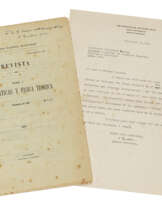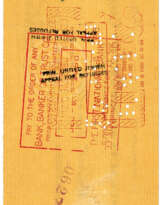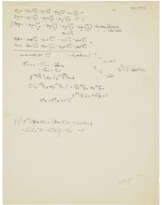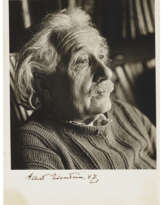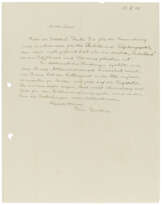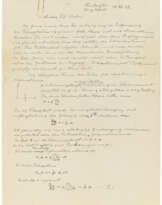ID 993274
Lot 86 | EINSTEIN, Albert (1879-1955).
Estimate value
£ 20 000 – 30 000
Typed letter signed ('A. Einstein') to [Morris Raphael] Cohen, Haberlandstrasse 5, Berlin, 10 May 1928.
In German. One page, 285 x 224mm, on paper with Einstein's printed name and address.
On his famous disagreement with Niels Bohr over the principle of complementarity in quantum mechanics. 'Our physics is currently becoming highly interesting again, because of doubts as to the possibility of enacting causality in the usual sense in space and time. If you are interested in the subject, you can orient yourself using the very fine and clearly written article by Nils Bohr which recently appeared in Naturwissenschaften and probably also in Nature. But I must confess that I do not believe in the definitive character of this change'. At the opening of the letter, Einstein recounts having recently seen a mutual friend, Herr Wind, who has given him news of Cohen's activities, and Einstein expresses sympathy with what Cohen has had to suffer from nationalist prejudice, something he himself has endured in the past, adding (with misplaced optimism) 'But to console you, I can say that this has pretty much ceased, men having a laudable need to turn to new follies from time to time. I am reminded of you every time that I take your fine leather satchel filled with music to friends' houses, in order to play music there'. A postscript notes that Einstein is not writing with his own hand as he is ill. The recipient, Morris Raphael Cohen (1880-1947) was a professor of judicial philosophy at the City College of New York.
The celebrated debates between Einstein and Niels Bohr over the validity of the Copenhagen Interpretation of quantum mechanics are of critical importance to the modern understanding of physics and to the philosophy of science. Einstein's first main salvo had been at the celebrated Fifth Solvay Conference between 24 and 29 October 1927, where he challenged Niels Bohr's fundamental tenet of complementarity, which holds that objects have pairs of complementary properties which cannot be observed or measured simultaneously. The article Einstein here references – ‘The Quantum Postulate and the Recent Development of Atomic Theory’ (published simultaneously in German and English, in Naturwissenschaften and Nature, respectively) -- was in fact a refinement and expansion of the very paper which so sparked Einstein’s indignation at the 1927 Solvay conference. Its articulation of the complementarity principle is recognized as the cornerstone of the Copenhagen interpretation of quantum mechanics, which became the prevailing view of quantum physics in the 1930s. The Bohr-Einstein debates went through several distinct phases of argumentation over the course of a decade, culminating with the entanglement and non-locality paradoxes of the famous 1936 Einstein-Podolsky-Rosen (EPR) paper. Even today, some philosophers of science still deem the debate to be unresolved.
Special notice
This lot has been imported from outside of the UK for sale and placed under the Temporary Admission regime. Import VAT is payable at 5% on the hammer price. VAT at 20% will be added to the buyer’s premium but will not be shown separately on our invoice.
| Artist: | Albert Einstein (1879 - 1955) |
|---|---|
| Place of origin: | Western Europe, Germany, Europe, Switzerland |
| Auction house category: | Letters, documents and manuscripts, Medicine & science |
| Artist: | Albert Einstein (1879 - 1955) |
|---|---|
| Place of origin: | Western Europe, Germany, Europe, Switzerland |
| Auction house category: | Letters, documents and manuscripts, Medicine & science |
| Address of auction |
CHRISTIE'S 8 King Street, St. James's SW1Y 6QT London United Kingdom | |
|---|---|---|
| Preview |
| |
| Phone | +44 (0)20 7839 9060 | |
| Buyer Premium | see on Website | |
| Conditions of purchase | Conditions of purchase |



